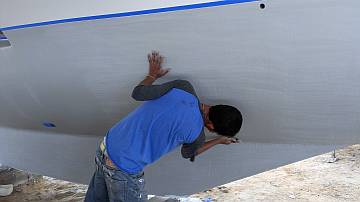
Baw roughing up the hulls so the antifouling sticks
121 Final Frenzy
Summary: Goodness - so much accomplished as we head for a March 3 launching. The big items were putting on the antifouling, finishing the salon headliners (a huge job), dismantling (and selling!) the tent, and erecting the mast. But the list of smaller jobs is much longer. Team accomplishments this week include:
|
 Baw roughing up the hulls so the antifouling sticks |
Monday, February 24: First Antifouling
Oh my Gosh. 7 Days to go, and lots more than 7 things still to do. Is it time to panic
yet? Until this refit we'd never been on the hard for more than
a week. Now we're trying to make sure something doesn't slip through the cracks after more
than 2 years of work.
Today the first coat of antifouling went on. In the morning, Baw and Heru hand sanded the underwater surfaces with 80 grit, then taped the paint line (which is about 3" higher than the actual waterline) and cleaned the hulls.
 Pla rolling on the first coat of ablative Interswift antifouling |
After lunch, Heru switched to helping Houa with headliners, and it was Pla and Baw who mixed the black International "Interswift" antifouling, adding a touch of thinners to help it roll on better. We've never added thinners to our antifouling before, but it seemed to roll on more easily. Interswift is an ablative antifouling that comes in 5 liter cans, and we bought 2 cans of black for the undercoat and 3 of blue for the top coat(s). When the black starts showing through, we'll know it's time to put on more antifouling.
Houa and Heru actually got several long headliner panels screw‑mounted in the salon! It was looking very promising for a wrap‑up of this job. Then came the fun of trying to fit the newly varnished galley shelf assembly back into place behind the stove/oven. It just wouldn't go in. Jon joined the fray and the 3 men tried every angle possible to push it in place, but no luck. They finally had to remove 2 of the long headliners, place the triangular shelf, then re‑mount the headliners. The shelf is now in place, never to be removed!
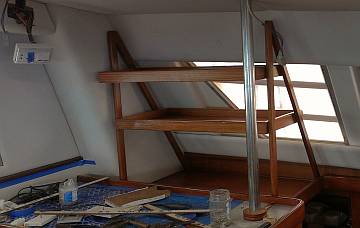 The galley shelves are finally nestled into their home |
Jon's day began in the galley where he got the switch plate set up with both 220v and 110v sockets, to go next to the 2 switches for galley lights and the propane solenoid. Houa cut a small notch out of the headliner, allowing the sockets and switches to be mounted more securely than they were before.
Then Jon moved to the galley sink, and asked Sue to go find the fittings that go between the faucet and our water system. Unfortunately, the faucet fittings seem to be unique to the US, as Sue was unable to find anything even close, even after taking pictures of the fittings to show the store folks. Looks like Jon will have to go see what IS available, and design some sort of work‑around.
 Jon reassembling the big block for the main halyard |
Sue was more successful at Rolly Tasker, finding packets of 3/16" (4.75mm) Torlon ball bearings for our broken main halyard block. But at US$0.50 for each tiny ball(!) we didn't buy many extras beyond what we need to repair the block. The coup of the day, though was that Johnnie, the manager, found a yachtie with a car who was leaving right then, and agreed to deliver our cleaned jib and repaired sail cover to the yard. The catch was that he didn't know where the yard was, so he'd need to follow Sue's scooter, which proved challenging (to Sue). In Thailand, scooters generally go the front of the line at the traffic lights (there's actually a designated area for bikes ahead of the cars), and then they accelerate off the mark faster than the cars and get a jump on all the traffic. With a car following her, Sue had to hang back and wait out each red light just like she was a car, but she was successful, and our sail and sail cover were delivered safely!
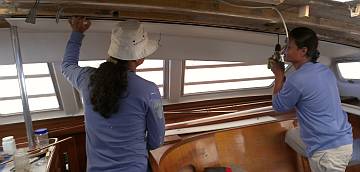 Heru helped Houa install headliners in the salon |
With the new balls in hand, Jon was able to re‑assemble the broken Frederickson block and get it mounted on the main halyard on the mast. Then he began the tricky job of cutting down the 2 cap shrouds (the cables that hold the mast on the sides) which have been tied and plastic‑wrapped up in the rafters of the tent for 2 years. Baw and Pla helped, as it was awkward handling the heavy 60' (18m) long cables without dropping them or letting the heavy ends bang onto the boat. Once down, the men lined up the shrouds on the tables next to the headstay, and Pla began polishing the stainless steel turnbuckles. Baw did a quick wipe‑down of the cables themselves with acetone and a rag to remove the majority of the Chennai (India) coal dust, but Sue will request a further soap and water and brush cleaning tomorrow so we can see the condition of the cables better.
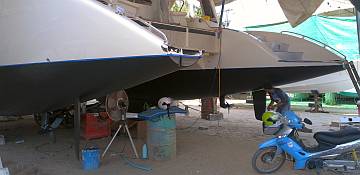 Ocelot with her new black bottoms (should be blue tomorrow) |
The shrouds have been covered in loose‑fitting PVC pipe from St. Martin that allows the sails to slide along the shrouds. But these pipes are now over 12 years old, and looking a bit used. The local hardware store only carries pipe suitable for underground, but we got a lead from the men on where to go tomorrow. Jon stopped at our favorite machinist to see if they could make up some big plastic washers which we put between each pipe section up the shrouds, and those will be ready tomorrow as well. We are still awaiting the radar bracket these guys are making for us, and hope to have it tomorrow so we can install it before the mast goes up.
There's a rumor that we're to go on the trailer tomorrow, to be moved out from under the tent. Alternatively, if we can disassemble the tent we won't need to be moved and we can do the last antifouling under the keels at the last minute like we always have. Stay tuned.
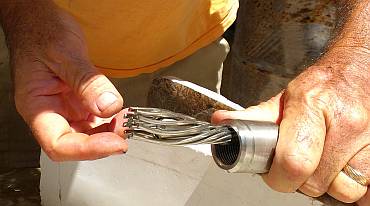 Outer strands un-laid, cone inserted, and strands re-laid |
Tuesday, February 25:
Another hopping day on Ocelot, with so many things going on. Last Tuesday on the hard (we
hope) if all goes well.
Jon was in major engineering mode today as he took on the role of Rigger. The first step was to cut our ($1,000) headstay to the correct length so we can install our Norseman terminal on the top. The bottom already has a swaged terminal, but the top had to be left empty so we could slide the extrusions of roller gear over the wire. We have length notes we made when we took the headstay apart, but the bottom turnbuckle has changed and things are different lengths now. Sue was happy to play assistant and hold the tape and try not to disturb the thinking. Once Jon had determined the proper length of the new headstay cable, he used a cutting wheel on the grinder to slowly slice through the 12mm Dyform cable.
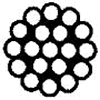
 Normal 1x19 wire vs. Dyform |
Marine rigging wire is typically 19 strands of steel: a central wire in the middle, a ring of wires around that, and another ring of wires around the whole bundle. Normal 1x19 wire uses the same size strands throughout, but our Dyform wire uses specially shaped strands that pack 30% more steel (and 30% more strength) into a given diameter of wire. To put a Norseman terminal on, you first slide the conical outer nose of the Norseman over the wire, then unlay the outer strands of wire and slip a small, hollow metal cone over the inner strands. Then the outer strands are put back, the ends are bent over the small cone, the outer cone is pulled up against the wires going around the smaller cone, and the end piece is screwed into the outer cone, capturing the wires and squeezing them around the inner cone.
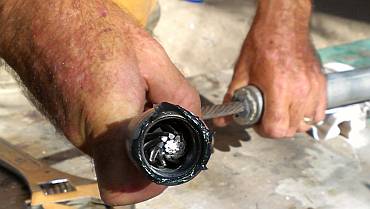 Strands nice and evenly spaced, looking good |
We've used Norseman terminals since we had our trimaran in the 1980's, but the rigging wire was much smaller on that boat. Trying to unlay and then bend the big outer strands of 12mm Dyform into the right shape is quite challenging, so Jon practiced on the cut‑off section. As usually happens, the practice made the real thing go much easier. Once Jon had the 2 halves of the Norseman together, he screwed them together tightly, then unscrewed them to check how the wires were laying inside the terminal. Everything looked good so he reassembled the Norseman and tightened it hard.
While Jon was playing rigger, Pla and Baw rolled on several coats of blue antifouling over yesterday's black. Our goal was to have them roll a wide swath just below the waterline, plus the rudders, sail‑drives and bows (the places that get the most wear and tear). Then while that starts to dry, go back and roll blue below what they just did. Then end this round with another coat over the high wear areas. This ends up putting 2 layers on the high‑wear areas and 1 layer elsewhere. Then we let it dry overnight and do it again.
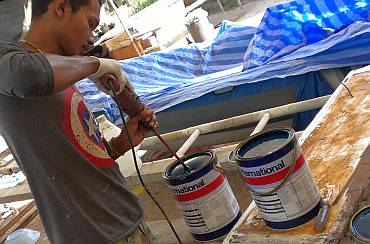 Baw mixed the antifouling, but not as often as we do |
But oh my gosh, it was so very difficult to get this idea across. The men wanted to paint it all, or just some of what we suggested. Then they didn't understand when they were to go back over the new swath at the waterline. Then they forgot the rudders. Sue finally pleaded with Baw to just do it the way we say, even if he didn't understand (we had tried to explain our reasoning to them, but we think it made things more confusing). Bottom line, we have been putting antifouling on our own boats for 18 years and we may be crazy "farangs" but we want this one last big job done our way. They sort of got it right, then took a break for lunch.
Sue spent the morning cleaning up rigging bits and scrubbing the cap shrouds with wire brush and soap and water. What a difference that makes. Goodbye coal dust, hello shiny stainless steel! When Heru wasn't needed to help Houa he got some more rigging pins and the turnbuckles for the cap shrouds all polished up nicely.
 The blue is darker than we expected, but still nice |
After lunch the men took on other jobs while the morning's antifouling finished curing (the specs call for 4 hours before over‑coating in our climate). Pla took over the cap shroud cleaning job. We retrieved the 4 big teak doors for the heads from the store room, and Heru and Baw became door‑mounters. They also got the copper grounding strap screwed into the interior of the big hanging locker, and got that locker door mounted.
Houa and Heru added more wonderful white panels to our salon which feels really good. Maybe there is hope for it to be finished before the weekend!
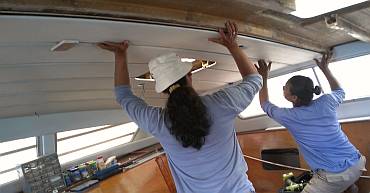 Heru and Houa mounted several more headliners in the salon |
Sue ran a bunch of errands after lunch. She checked on the progress of Thai Sailing and our dodger and side flaps for the bimini. It's ready! Sitting right there in the office, but with no one to deliver it and test fit it. Hopefully tomorrow. She also asked them to send the truck so they can take away our new foam mattresses which are a bit too tight. We hope they can do a fast turn‑around time on cutting the foam and stitching up the mattress covers to fit snugly. We definitely need these back before we're on the water, as we really don't want to transport big pieces of foam in the dinghy!
Sue also picked up the newly welded aluminum radar mount from Lop at the local machine shop. And she dropped by AquaMaster near the Chalong Circle to pay for the scuba gear repairs. The good news: they will deliver tomorrow and our 3 tanks all passed their visual and hydro tests and got the paint stripped off for corrosion control. The bad news: we need 6 new 2nd stage regulators for the 3 regulator sets, and that will be big bucks. But right now we have filled scuba tanks and no regs, which isn't very useful.
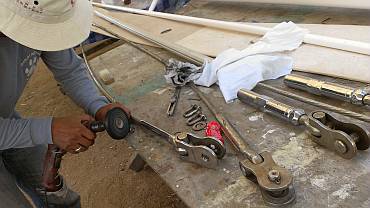 Heru polished up the cap shroud end fittings |
Sue returned to the yard to find the men finishing up the last of the antifouling (save a little bit for under the keels when they lift us off the blocks we're sitting on). It was fun to see the blue tape get peeled off at the waterline. This is always such a satisfying moment! Jon had the 2 cap shrouds mounted, and the turnbuckles all set up on the deck ready to receive the wires. We all lifted the finished forestay and Jon got it mounted to the mast tang. Next step: mount the Profurl top swivel and bottom drum.
The yard wanted to put Ocelot on the trailer today and slide us out from under the tent, but we begged for an extra day as the men were still painting. The new idea now is to disassemble the tent from over the top of Ocelot on Thursday, and then the yard can bring the crane right next to Ocelot and lift her mast on from where we are right now. It means neither Ocelot nor the mast will have to move before they're reunited, which saves everyone a bunch of work.
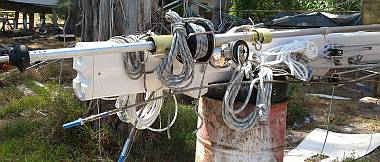 Ropes, wires, & rigging all tied up at the base of the mast |
Wednesday, February 26: Name and Radar
A Momentous Midweek as we zoom along towards the finish line.
Sue, Heru and Baw took scooters to the (slightly more upscale) hardware store up the road towards Phuket town to see what they have in plastic pipe. Our cap‑shrouds have been covered in French "exterior grade hot water pipe" as chafe preventers for the sails. The plastic pipe rotates nicely as the sails slide on by. But after 13 years, the pipe was a bit worn out, so we hope the local Thai PVC lasts as well. Sue went along to ask questions (translated by Baw) and to pay. The men did their awesome Thai scooter trick carrying 8 pieces of 4m (13') long pipe. Sue also stopped off at Phuket Art for our Ocelot stickers.
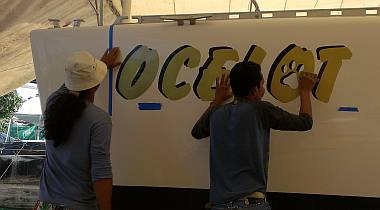 Heru and Baw squeegee-ing Ocelot's name onto her hull |
Jon fiddled around on the mast all morning without photographer Sue nearby, and the next thing she knew we had the roller gear with both swivels in place on the forestay, and Wait! What's that? The black plastic dome piece is supposed to go at the TOP isn't it? Clever Jon, had temporarily put a 2nd "wrap preventer" at the bottom to hold the roller gear sections from sliding down the forestay when the mast is vertical. This will let us futz with turnbuckles and such without having to worry about the extrusions.
Baw and Heru cleaned the topsides where Ocelot's name sticker is to go, while Jon and Sue added comments on placement. Finally we were all in agreement, and Baw sprayed the boat and Ocelot's sticker with soapy water, then slid it into place. Lots of careful squeegee‑ing with a soft foam pad gave us our beautiful name back! Happy!
 Heru & Houa made excellent progress with the salon headliners |
Pla drew the messy‑job straw yet again (probably because he's good at those sorts of jobs, and never complains). He spent much of the day upside down in the new diesel tank lockers. These had been poorly painted last year, such that each had a broad stripe of uncoated epoxy and glass on the inner walls, and the sides and floors of each locker were a mess of spilled epoxy and stains. When the rest of the boat is looking brand new, who wants to open a locker to put the fenders in and feel like you're looking into some neglected corner of the boat? So Pla sanded the side walls and got a fresh layer of white enamel painted on. Tomorrow he'll spend more time upside down as he sands the floor (we caught him sanding with his feet, clever guy) and then putting on a fresh coat of white gelcoat for durability and waterproof‑ness.
Houa and Heru (who worked many different jobs today) made great progress in the salon today. Lots more overhead headliners got mounted, and they tested the fit of the fiberglass/gelcoated interior trim around each of the 3 big salon hatches. Some need a bit of fiddling, either on the trim itself, or changing the height of the supports of the headliner. They got the big pieces to the starboard side over the windows mounted. Only 2 to go, and Houa hopes to have them done early tomorrow before turning to the tables.
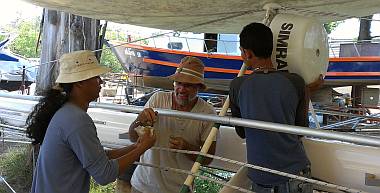 Mounting the radar & the new mounting plate on the spreader |
Just before lunch we had a surprise visit from Daryl (Cool Bananas) who is leaving Krabi Marina now that the prices have tripled. Our discussions with Daryl always lead to cruising envy, as we talk about coral reefs and atolls in the South China Sea.
Jon gathered Baw and Heru to help with the mounting of the radar dome on the first spreader of the mast. The aluminum mounting plate that we had made by Lop, the local machinist, sits on our first spreader, which has a slight crown, so the welded‑on aluminum strips had to be carefully ground so they'd match up with the crowned spreader. Jon got new mounting holes drilled, then used Duralac anticorrosive between the stainless steel bolts and the aluminum. If we'd had the bracket made a few months ago we could have had Baw paint it to match the mast, but Oh Well. A bit of raw aluminum up there under the gray radome won't kill us.
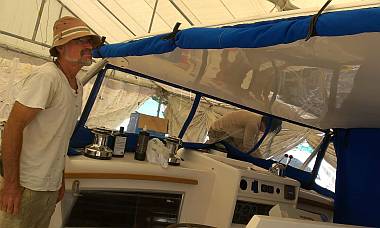 Checking the fit and finish of our dodger and side shades |
The men from Thai Sailing came by and spent a couple hours on the boat fitting the new dodger and side flaps. It's all looking really great, but there are still a few things to tweak, like moving the tie‑down webbing straps higher up the cloth, adding double‑sided zipper pulls so we can fasten the cloth from either side, and adding reinforcing straps to near the pulls as Jon really likes to pull the cloth tight to keep it from flapping. Sue grabbed a couple of the men (who spoke some English) to see what we can do (fast) about the over‑sized foam mattresses on the bunks. It took a while to be sure they understood we don't want to change the (brand new!) foam, but just want a bit cut off so they fit better. We think they finally got the idea, and offered to cover the foam in thin white cloth to make the covers slip on and off easier. They will also repair the (new, poorly made) covers to fit very snugly. They're going to try to get it all done by tomorrow afternoon! Cool!
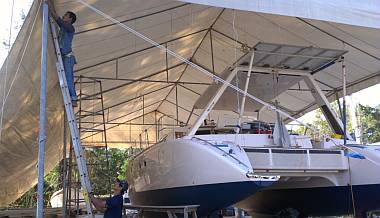 Cutting down the 4th side-flap on our tent |
The end of the day saw Sue back at Phuket Art getting a replacement "Seattle WA" homeport sticker. She had somehow forgotten that mounting it dead center on the aft deck means the big storm anchor completely covers it. A real brain blip. So for $10, Phuket Art made a new one while she waited, and this will be mounted at the top of the sugar‑scoop on port side.
She returned to find the men folding up an immense white plastic tarp, taken down from the starboard side of the tent. The men then moved an expanding ladder around the boat and cut down the other 3 big shade tarps. Sunshine hit Ocelot's port side for the first time in a year! We hope to disassemble the tent itself tomorrow morning with the help of a worker from TMT (who built the tent).
Thursday, February 27: Remove Tent
We passed another major milestone today. Not only is the tent down, but it's sold and gone!
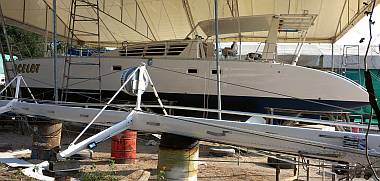 Ocelot's last morning under her wonderful tent |
Our 3 men (other than Houa) all knew that their main job of the morning (and maybe the whole day) was the removal of the big tent that's covered Ocelot since she was hauled out in November 2011. At 8:30 we already had Baw, Pla and Heru up the scaffolding and extendable ladder cutting, then unlashing, the twine that held the main PVC tent canopy to the metal structure. Jon got up there as well, and the cover was pushed, pulled and poked off the frame and then folded on the ground.
Soon after that, 3 pickup trucks rocked up with the new owner and 6 more men. They had come all the way from the north end of Phuket (some 45 miles, in bad traffic) along with Ditapong, the owner of Premier Boatyard. Immediately things speeded up and we had 11 men crawling all over the scaffolding, tent trusses, and on Ocelot. At first Jon tried to play engineer with suggestions for safety or efficiency (all the while looking out for the care of Ocelot as well), but invariably he ended up letting the men do it their way - the slightly disorganized pandemonium that Thais seem to revel in. An older man from Premier seemed to have the whole plan in mind and orchestrated the moves. Not always the way Jon would have, but we had no mishaps to either men or boat, so all was well. The entire tent was dismantled by noon and the 10m (33') trusses were cut in half(!) to fit in the back of their trucks. We were paid for the tent, and an hour later the pickup trucks were loaded up and leaving. YAY!
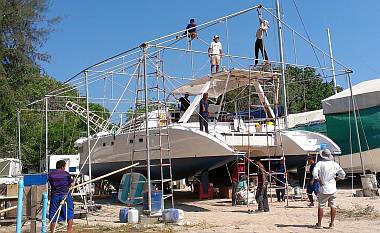 The cover came off easily, the steel was much harder |
But now Ocelot was exposed to the hot midday sun. We had to pull off the black vinyl coverings on the sugar scoops as it was unbearably hot to walk on. Sue also pulled back the clear cling wrap on the swim ladders and hand rails, only to find that the vinyl had somehow reacted with the electro‑polished stainless and left golden stains on the metal. We hope this polishes off easily. It didn't happen to areas that were always out of the sun so it must be a UV/vinyl reaction.
Sue had a morning appointment with Jaray, the owner of Thai Sailing to discuss the bunk mattress coverings. They had already cut off the requested 1/2" (1cm) from some edges, but she was shocked to see they were ripping apart the seams from the blue and red coverings made by the local seamstress. Granted, the covers had been poorly made, but we thought Thai Sailing could just tighten up the seams. Turns out their fancy serger‑type machines needed more fabric than was left if they just moved the seam inboard a bit. Mucho more work than we thought. Ouch on the wallet. But the good thing is they promised to get the bed cushions finished by tomorrow or Saturday at the latest, so we don't have to transport them over the water! Jaray also asked us to check the new curved cushions to be sure they are good. Sue did that in the afternoon, and was not happy to find that they don't fit like they should. More work to be done.
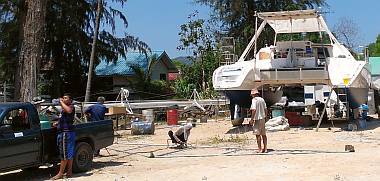 The 10m trusses were cut in half(!) for transportation |
We got some alarming news today. The boatyard just bought a new 10 ton crane with a 21m (69') reach, but it's somewhat computerized and the control screen is all in Japanese (or possibly Chinese). Manoon can't read it and is still trying to figure out how to control his new toy, so we asked the yard if they could please order us a more experienced crane. They didn't have a problem with this, but after calling many companies they reported that they could only get a crane on Saturday, March 1st. This will give us only Sunday to get the mast rigging setup and the electrics hooked up, which is pushing things to say the least. But the good news is that Sue was able to rent us a beat up old pickup truck (bakkie, ute) for Saturday and Sunday to move boxes, the washing machine, etc, and to provision the boat.
Jon checked all our sea‑cocks and found 4 that needed some attention. Since we consolidated shower drains, 2 of the old drains still had to be removed and their pipes plugged. The starboard aft toilet inlet needed reconnecting, and an old fridge cooling inlet (that we never use) needed an appropriately sized hose‑barb, but that will have to wait for tomorrow. Jon left all the sea‑cocks closed (except the engine intakes) so we don't have any surprises as they launch us.
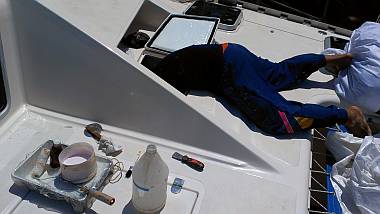 Pla gelcoating inside the port diesel tank locker |
Pla spent the afternoon (in the hot sun) on his belly, head down in the diesel tank lockers up forward. He had already done the sanding yesterday, but today he did a final acetone wipe, then mixed and applied gelcoat to the "floors" of the tank lockers. It was a good use of the extra gelcoat that Baw had mixed too pink last month, so now the diesel tank lockers have fancy pink floors!
Baw finished cleaning up and sanding the metal cover for the compass binnacle, and also the cone that holds the helm wheel on. He gave them both got a nice spray of white enamel paint. Then he applied the (second) Seattle WA sticker to the stern, this time at the top of the port sugar‑scoops, where it can be seen, instead of behind the big anchor! Heru did a heroic job of cleaning up the sand under Ocelot and everything looks so new and pristine!
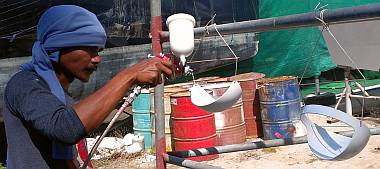 Baw sanded and sprayed the compass cover & wheel lock |
Houa had a frustrating day, in that the very last piece of salon headliner was both too long and too wide. Which means he had to take off his newly glued‑on strip of plywood and Velcro from the long edge, and peel back the vinyl and foam to cut the main headliner board. He got it mostly done and fitted before day's end, and is still asking for the cockpit and salon tables to work on (hinge areas need routing) tomorrow.
Sue made numerous trips to the store room to search for old food (yuck!) to throw out, and also any clothes or linens to wash while we have access to unlimited water. We'll be on cruiser's boat rations once we're back on board. Heru helped her tie an immense bag of linens onto the back of her scooter, which she delivered back to the apartment.
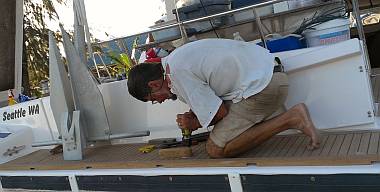 Installing chocks for our (huge) Fortress FX-125 storm anchor |
Jon enjoyed the cool of the late afternoon (Ocelot gets in the shade after 4pm) and got the 2 Yanmar Instrument panels in the cockpit mounted to the helm station. He set them in with silicone like they had been before. We had contemplated replacing them with newer versions, but at $1000 each(!) we gave it a miss. Jon then turned his attention to the chocks for our huge Fortress FX‑125 aluminum storm anchor that we keep on the aft deck. Houa had made new chocks months ago, so we were eager to see how it all mounted. Strangely, we must have had the anchor lifted a bit off the deck, as the 2 end brackets raised the anchor into the air. Engineering re‑think time, as we can't find any photos of this area. We'll probably let the base rest lightly on the teak, but cut the end brackets down so the anchor rests heavily on them, but still touches the new teak pads.
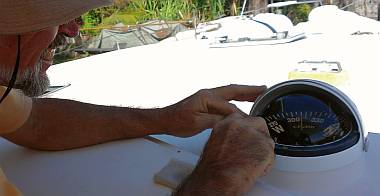 Jon assembled and mounted the newly painted compass cover |
Friday, February 28:
A Butterflies‑in‑the‑Belly sort of day, as Ocelot felt air under her keels for the first time in
28 months. We got moved! But lots of other things happened, too.
Jon moved around the boat like a mighty engineering force. He got the wheel mounted at the helm station, so now we can steer ourselves somewhere. He got the compass cover put back together and installed after its enamel painting, and he got the storm anchor chocks cut down and screwed in place with Sika on the aft deck. He reattached the handle of the raw water intake valve on the starboard engine, and mounted some more of our sailing instruments. He mounted one of our 3 internal GPSs and, somewhat surprisingly, it works, so we now know where we are. He connected the propane system, tested the propane solenoid, connected up the sparkers for the stove and oven, and tested all 5 burners on our new Dickenson cooking unit. In an effort to be ready for the Great Mast Raising tomorrow, he and Sue collected things needed for the rigging. That meant finding and checking the stainless toggle for the headstay (we hadn't been sure which of the several toggles lying around was the right one), gathering lanolin grease, the monster big shifting spanner and several smaller ones. Everything is now gathered in a "Chagos Bucket" - a home‑made bucket from the bottom of an old plastic jerry jug, cut and drilled for rope handles. Very useful!
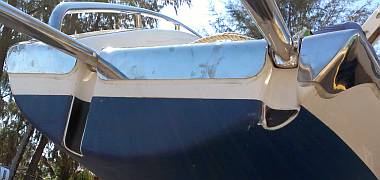 Baw's rubber padding in the ladder grooves in the transom |
Sue led a parade of 3 to the store room and back, bearing many new salon cushions. There was a mad scramble to clear the seats of all the tools, screws, bolts, and miscellaneous hardware that is scattered, so that we could place the cushions. Thai Sailing (our cushion people) arrived within moments of our cleaning up, and got to see how the rounded cushions on the corners just don't have enough curve to them. So they whisked them away to maybe put slots in the back to allow for more curve. We think they were saying that slotting foam is old fashioned, but we can't think of a better way to make it curve.
Baw scraped back the antifouling in the ladder grooves on the transom, then cut some rubber sheeting to provide some cushioning for the ladders when they're down and stuck that into the grooves with some Sikaflex. We'll have to put some more antifouling in those grooves now.
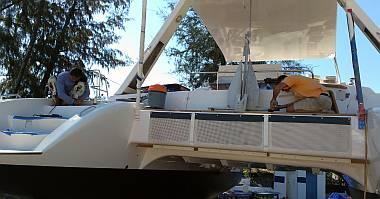 Heru doing the steering covers, Jon on the anchor chocks |
Pla was Mr. Polisher today. A lot of elbow grease and Weenol (a German polishing paste) brought our tarnished swim ladders and handrails back to their electro‑polished sheen. It will be interesting to see if the electro‑polishing is really worth it. Obviously, the Bangkok company didn't hesitate to wrap the newly polished stainless steel in tight cling wrap. A warning to remove it soon might have been nice. Pla also cleaned up the taped‑over swage threads on the bottom of the headstay so now it's all cleaned up and ready to get greased tomorrow when the mast goes up. The most interesting things Pla polished (and we'd never have thought of it) were the 2 white, hard rubber winch handle holders that live mounted to the helm area and the mast. Both were pretty yellowed with UV aging and generally grubby looking even after a wash. After sanding with 400, 600, 1000, and 1200 grit sandpaper then the machine polisher, they came up shiny and almost like new!
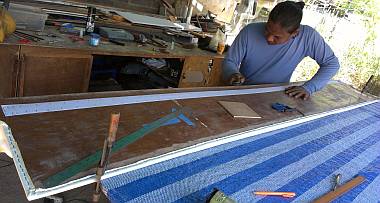 Houa had a frustrating time with the last long headliner piece |
Heru worked on a variety of small jobs when he wasn't helping Houa with headliners. He re‑set some of the locker door latches and their button pushes, and cleaned up a previously ignored locker in the starboard passageway where we had had water pumps and strainers mounted. His main job today was to prepare the covers for the emergency tiller access holes. These are round areas cut into the sugar‑scoop steps, where we can stick a mechanical tiller if the steering breaks. The plastic access plates and their bases didn't fit well so Heru opened up the holes and trimmed back the cover plates a bit until they did. Then Jon screwed them into the deck.
Sue was in and out all day, buying screws for 4 different projects (all at different times of the day). She took off early from lunch to get a load of white linens washed at the apartment then scootered to the International Hospital to track down her medical records from last year's broken wrist, for which we can claim some insurance back. Just haven't had the time or energy to do it, but once we're on the water it will be even harder, so today was the day. As usual, she kept track of who was doing what, and who needed what supplies, and what jobs needed doing.
 The boatyard's catamaran trailer & one of their 2 tractors |
Houa had to completely re‑make the plywood and Velcro edge of the last long headliner piece, which took him much of the day. He was still working at 6pm, about to glue the plywood edge to the headliner. We can already see that we won't get all the little woodworking projects done that we (and Houa) wanted, but maybe if Baw has time he can take on some.
In the morning, Jon had approached Manoon and Lang, the manager, to ask if Ocelot could be moved out about 20' (6m). Now that the tent is gone, we can see that there isn't really room for a crane between Ocelot and the mast. But the trailer they'll use for Ocelot was being used for another boat that was hauled out today, and they said they'd block that boat up, remove the trailer, and put it under Ocelot tomorrow, before the crane arrives in the afternoon. OK ... (but not really ideal).
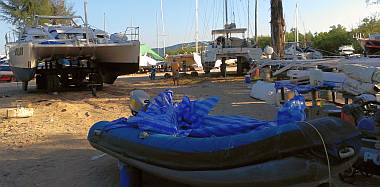 Our workspace, with Ocelot on the trailer and pushed back 20' |
So we were quite surprised when the trailer arrived (unannounced) before 4pm! We had a mad scramble to clear all the boxes, motorbikes, ropes, buckets, and projects out from under Ocelot. The trailer picks us up under the bridge‑deck, but the upper rails were too high, so they had to swap them out. Then they had to dig shallow trenches for the wheels of the trailer so it would fit under Ocelot (this is really our fault, as Jon had shoveled a lot of sand under Ocelot back in the rainy season, to keep the water from pooling under the boat). Manoon sounded out our bridge‑deck to find where the bulkheads are, then put on padded blocks to take Ocelot's weight. Then they put big hydraulic jacks under the trailer(!) and lifted both Ocelot AND the trailer, so they could remove the blocks that Ocelot has sat on for all these months. With the blocks removed, they lowered the jacks and pulled us back about 20' (6m), which should give the crane ample room to work.
It wasn't until the trailer was nudging under us that we realized that we wanted to hoist Tomcat (our big inflatable dinghy) in the davits. But the hoisting system wasn't in place yet, so Jon grabbed the various blocks and new line and strung up both the bow and stern pulley systems, and ran the stern one (that lifts the motor) through the targa bar and out to the winch. We'll need a few men to help move Tomcat through the soft sand, even with the big wheels, to get it in position for hoisting. Just thinking about having the dinghy on the water gets the blood pumped up with excitement. Ahhh, cruisers. We're so easy to please!
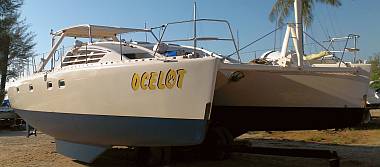 Ocelot looking beautiful in the morning sun |
Saturday, March 1: Mast UP!
A heart‑stoppingly stressful day, but all went well, and we are closer to being a sailboat once
again! Masted and Boomed now!
We began the day with every intention of taking Tomcat, our inflatable dinghy, out for a test run on the bay, but we got held up with details (nothing new there.) Tomcat needed a new plug to keep the ocean out of the drain hole, so Sue scootered off to find one. Jon needed to tie the dinghy cover back in place so it wouldn't flap all over the ocean, and we needed a rope painter, just because we wouldn't want to forget it. By the time we could have hauled the dinghy to the beach, it was late morning and the chop was up on the bay. So Jon fired up the engine momentarily (dry) and checked that it went in and out of gear, and declared it FINISHED.
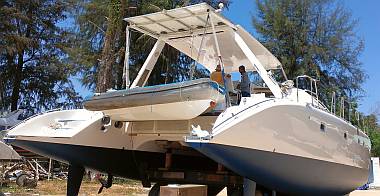 Tomcat snuggled into her davits, ready to sail |
Then the men hauled Tomcat back to the stern of Ocelot where Jon had set up the hoisting system at the end of the davits (poles that support the dinghy in the air). Luckily the new stern line reached all the way to the engine hoist cable in the dinghy, but there was no way the bow line would reach with Ocelot so high. No worries. Pla and Heru simply lifted the (not light) dinghy bow until Jon could snap the hoisting hook on Tomcat's hoisting cables. The davits had been moved aft by 7" (18cm) or so when the new bimini was put on, and we were curious if that would let the dinghy come up without having to push it out to clear our lazarettes. It didn't (Tomcat's pretty wide) but the effort is much less now, which is about what we'd hoped for, as we don't want Tomcat swinging around out there when we're sailing.
Baw arrived late morning (not sure why!) and we set him up to add small rubber bumpers under the swim ladders where they touch the deck in their swim‑platform grooves. He chose to use blue Thai nonskid rubber, which he cut into small pieces. Then he used Sikaflex to stick them down inside their grooves.
 Houa built a table saw to slit the PVC pipes that go over the caps |
His next project was to attach Velcro strips to the underside of the big (totally comfy) helm seat, which has always had a tendency to slip part way off the seat. Velcro is difficult to bond to, so we wanted to use Sika to hold the Velcro in place. Baw didn't like the idea and wanted to use contact cement on the cushion, as the Sika would take to long to cure. Hmm. Maybe between the cushion and the Velcro it's OK, but we really thought it would be good to try something new for the hard seat surface and the Velcro joint. Too late, he had put contact cement in place. Oh well, if it falls off we'll peel it back and try the Sika!
Pla painted antifouling under the keels where Ocelot's been sitting on her blocks and in the grooves where Baw put the rubber sheeting yesterday. Then he finished polishing the stanchions, but it wasn't a nice job out in the sun. We found him hunkered down under a shredded piece of white tarp for shade. He happily went off to the store room with Sue to gather more goodies. The men probably think we're weird, in that we're only bringing a few things back at a time from storage, but in fact it's overwhelming to have too much clutter on the boat at once. Better to leave the clutter to the store room for as long as possible! Pla's afternoon jobs were to finished polishing the winch handle holders, and to clean up the 220v power cable which we no longer need. We're Off the Grid! Ocelot is running on internal power only (and it's better than the yard's power). The men did bring back the 2 buckets of chain for the storm anchor, so they got set up on the aft deck, where they've lived for years.
 Gently lifting the mast for the first time - it stayed totally straight |
Cruising buddies on Boundless Tu were wonderful and offered us their rental car (Nina's cruiser's special junked out Nissan) for 2 days. So Sue drove in and the car was used to haul some of the store room junk. She also picked up fuel for the dinghy at the nearest gas station, which is several miles away. She has decided that driving a car in Phuket is scarier than riding a motorbike. The car is so big! The streets are so small! And there are other big cars trying to fill the very narrow lanes. Sue has been driving back and forth to the apartment to run herd on endless loads of wash. Should have started this project earlier, as we seem to have more clothes and bed linens than we remembered. But we really don't want to move aboard with musty smelling clothes or sheets! The room looks like a kid's idea of a play house made of sheets!
After the dinghy work in the hot sun, Jon found himself severely dehydrated. We have some isotonic on board, and Jon drank a lot of it, but he wasn't feeling very well, so he rode back to the apartment to rest. No sooner had he arrived than Sue called. The crane had arrived!
 Once the mast was in position, we had to tighten up the rigging |
Setting things up to lift the mast was incredibly stressful, as the operator spoke not a word of English. He did come up to look a the mast step on the boat, to see the destination, and he supplied a nice strong lifting strap for us to use. We wrapped it under the 2nd spreader and wired it to his hook, with an extra rope to hold it in place. We wrapped his heavy hook in a life preserver, to protect the mast. With a guide‑line tied to the base of the mast, we asked him to raise the mast a few feet. Jon was impressed that the mast didn't bend or wobble a bit. The diamonds held it absolutely straight as an arrow. The base was still on it's support drum, so Jon lifted it to see how close to the center of balance he'd placed the lifting strap. It wasn't light, but he could lift it easily, which was exactly what he wanted.
The crane operator was very responsive to our hand signals to raise (twirling finger pointed up), lower (twirling finger pointed down) and stop (a closed fist). And he went very slowly. He raised the mast up without letting our delicate roller extrusion touch the ground very hard, and we swiveled the mast around so it faced in the correct direction. Then most of us raced up onto Ocelot's bow to receive the control ropes and guide the mast to its base. Our mast base consists of 2 small stumps, about 4" (10cm) high and a bit more than half that wide. These slide up into big holes in the base of the mast, guiding it. Between the posts is a half‑cylinder of a hard plastic, lying on its side, and this is what the mast rests on. Ocelot's mast actually rocks fore and aft noticeably when we're sailing, sliding on the half‑cylinder. With Pla holding the headstay roller gear, we guided the mast to the base, positioned it, and it lowered down and snuggled home very easily!
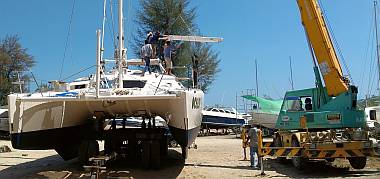 Lifting the boom into place was almost anticlimactic |
Then we had to connect up the rigging, which is only 3 cables for Ocelot: the headstay and the 2 cap‑shrouds, one on either side and slightly aft of the mast. Jon slathered each of the turnbuckle threads in a liberal coating of lanolin grease, ran the bottom thread into the barrel 5 turns (a trick he learned so the barrel doesn't fall off when you're undoing it) and then ran the top thread into the barrel. We didn't try to tune or even tension the rig, we just wanted to keep the mast from falling down and reasonably rigid - because then Jon had to climb up to the 2nd spreader to untie the lifting strap!
Next was the boom, which was the forgotten country cousin compared to the big mast. At first we thought we'd just have it raised to the deck, but hey! Why not bolt it to the gooseneck on the mast? So Jon setup the boom with a bridle of small ropes (ours) leading to a loop for the hook. With one guy rope at the aft end of the boom, it swung up, around the cap‑shroud, and over the boat. Everyone was a bit more cavalier about this little boom (after the immense mast) and the operator moved a bit faster, giving a few heart‑stopping moments as it swung near the shrouds, then back out. Finally corralled, they lined it up to mount, but the stainless steel gooseneck had burrs on the edges of the mounting hole, preventing the washers from positioning correctly. Jon started filing them down with his Swiss Army knife, then finally got out the big files. He was on the verge of requesting a grinding wheel and electricity, when it all worked out, and the boom slid into position. Baw and Jon got it pinned. Then Jon attached the new topping lift line (which is way too long for some reason - probably guessing at line lengths when in the States last year) and Ta Da! Boom in place! We are a sailboat once again!
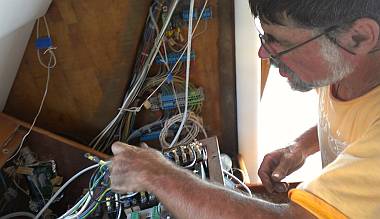 Jon worked on some electrical issues to wind down |
We all took a much‑needed break for cool Schweppes lime soda, and time to sit in the shade. One nice thing is that the crane then went to a neighboring boat that's having a big fiberglass bimini made, and lifted the (heavy, floppy) bimini into position. This means that we should get to share the $250 cost of the crane instead of having to pay it all ourselves.
Houa and Heru finished slicing the PVC pipe that will be used to cover the cap shrouds. They also worked on getting the hatch frames in the salon to nestle better against the headliner.
At 4pm the men from Thai Sailing arrived with the bunk mattresses and we placed the big blue ones in the forward cabins. They seems to fit well, and are snugly covered. Jon had to halt the placement of the aft cabin cushions so that he could make sure both engines are full of water and oil. But once that was done (quick job) we got them placed as well. They seem to have trimmed a bit much off the inner edges of the twin pieces for the aft cabins, but we'll live with it. No way are we having them done again! The bigger job to check was the side flaps for the bimini. They got the Velcro right for the roll‑up straps, and they changed and twisted (on purpose) the webbing strap pulls for the tie‑downs. But their reinforcing was on the wrong side of the pulls. Hmmm. Jon gave them a mini‑lecture on the engineering aspects of pulling force, and they seemed very willing to get it right. Only problem is, tomorrow is Sunday, so they don't work, and that means we won't get the panels back until first thing Monday morning. More stress as we get ready to launch. And no shade tomorrow, which we were hoping for.
Smile! We're a sail boat once again! She's looking beautiful!
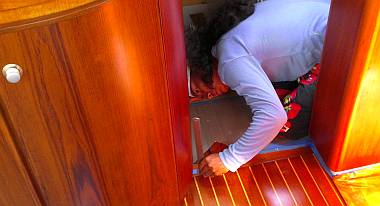 Heru installed an extra floor support just outside the galley |
Sunday, March 2: Moving Day
A long day, as we try to move everything onto Ocelot before they launch us around noon tomorrow.
Our dear friend Bruce from Migration drove all the way down from the top of Phuket Island to help us finish things up. This was WAY beyond the call of duty, as his wife is sick with a bad cold. One problem we have is that our galley sink is from the US, and the water connections aren't available here (that we've found). Migration is undergoing a refit as well, but they're several weeks behind us, so Bruce stripped the connectors off his own galley faucet and installed them on ours! He connected the fittings, tested them thoroughly, re‑did them once or twice as he found some weeping connections, and pronounced it good. Then he connected the drains for both sinks, so our galley is now basically functional!
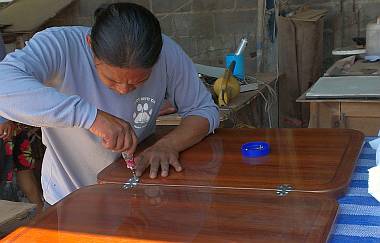 Houa worked all day installing hinges in our beautiful tables |
Houa, having finished the headliners yesterday, worked all day on our salon tables and the cockpit tables. Both tables fold out, but they didn't have their hinges yet. Since the tables have been extensively rebuilt, the hinges needed to be routed out so they lie flush with the surface. This is a quality of joinery that Jon can't match, so we're glad that Houa worked so hard at it. He finished the salon table (just 2 hinges) but was still working on the cockpit table (5 hinges) when we finally staggered out of the boatyard at 6:30 in the fading light.
When Thai Sailing took our big cockpit side curtains away for additional reinforcing yesterday, they told us they'd bring them back on Monday. So we were pleasantly surprised when they drove up in the early afternoon with the work all done! These should be a significant improvement over our old shades. They completely enclose 3 sides of the cockpit, we can deploy them when we're sailing, they roll up to the bimini for storage, they're significantly bigger (more shade/rain protection), and they include zip‑on triangular pieces that fill in the gap between the dodger (windscreen) and the side curtains.
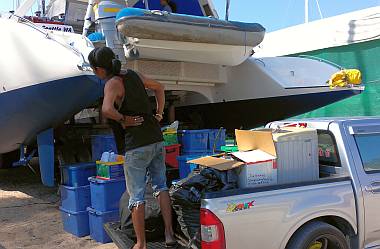 Some of the junk we have to put back on Ocelot - or do we? |
Sue was a whirling dervish in her borrowed car. She got the men to bring over ALL the boxes of stuff from our storage unit, and she organized a small truck to move all our junk out of our apartment, including the washing machine (but not her piano, which will have to go in tomorrow morning). Then most of our junk had to be lifted up onto Ocelot's decks, a HUGE job. You might be wondering why we need all this junk when we haven't used it for the last 2 years. Yeah, the thought occurred to us as well. We Shall See...
Heru put an additional support under one panel of our salon floor, as it was bending more than we liked. With all the moving of headliners finished, Baw could spend time repairing the scratches (caused by careless (ex) workers) in the varnish in the salon. He sanded the 2 big bulkheads lightly and then carefully brushed on another layer of Epifanes Brushed Effect. Then Jon realized that one project had fallen through the cracks. Our washing machine lives down the port fo'c's'le, with its back legs on a small shelf and its body tied to the bulkhead between the fo'c's'le and the forward cabin. But we'd forgotten to install the pad‑eyes on that bulkhead, and it's a balsa cored bulkhead, which means that it needs big washers on the cabin side of the wall. For Jon to do that, the men needed to remove the headliners around the bed. Unfortunately, those headliners are a bit of a puzzle, and they have to go in (and be taken out) in a specific order, and the headliner over that wall is the last one to come out. But Baw and Heru gamely went at it, and reported shortly afterwards that the headliners were all off.
 Bruce and Jon installing battens in the mainsail |
Jon spent most of the day on the mainsail, with wonderful help from Bruce in the afternoon. Jon ran the main‑sheet and vang lines, and the control lines for the main‑sheet traveler on top of the bimini. But when he ran the outhaul for the mainsail, it got stuck inside the boom several times, so we decided we'd better run the 3 reefing lines as well. A good thing, as 2 of the lines proved obstreperous, but we patiently showed them the error of their ways. Then came the stack‑pack (mainsail cover) and finally the mainsail itself. The main weighs probably 200 lbs (100kg) so 4 of us hoisted it onto the boom. Then we unrolled it and started connecting up all the bits. The 5 full length battens took the most time, as we decided to pin them into their forward holders. Tensioning the sail so we could get the big threaded batten slugs screwed in also proved difficult. But by the end of the day we had pretty much everything done except the lazy‑jacks (system of ropes that makes the mainsail fall straight into its stack‑pack) and a couple of blocks for the main‑sheet and the vang. Let the sailing begin!
Thai Refit:
Ocelot Pages:
Top Level: Home | Destinations | Cruising Info | Underwater | Boat Guests | Ocelot | Sue | Jon | Amanda | Chris | Site Map | Make a Comment
|
If our information is useful, you can help by making a donation |
Copyright © 2000‑ Contact: Jon and Sue Hacking -- HackingFamily.com, svOcelot.com. All rights reserved.